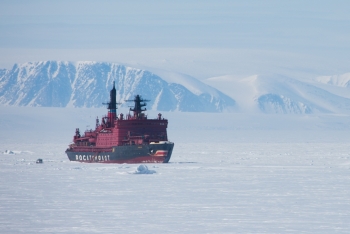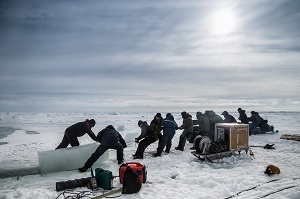Please activate JavaScript in your browser to use all interface options.
Kara-Winter-2015 has become the largest arctic expedition in the world in recent 20 years
16 June 2015
Kara-Winter-2015, scientific-exploratory expedition, organized by Rosneft with the support of the Arctic Research and Design Center and FSBI Arctic and Antarctic research institute is successfully completed. It has become the largest arctic expedition in the world in recent 20 years by the scope and the structure of works. Explorations lasted for ten weeks and involved the Yamal atomic icebreaker, which went from the Barents Sea up to the East Siberian Sea almost through all the shore of the Russian Arctic. The works took place on the water area of the Barents Sea, the Kara Sea, the East Siberian Sea, and the Laptev Sea, in the Novaya Zemlya, Severnaya Zemlya archipelagoes, Novosibirsk islands (including the De Long islands) and on the Land of Franz Joseph for the first time; they took place on East-Prinovozemelskys-1,2,3 North-Karsky, Ust-Oleneksky, Ust-Lensky, Anisinsko-Novosibirsky, Albanovsky and Perseevsky licensed fields.

The expedition included complex of meteorological, oceanographic, ice patrol, glaciological and biological observations. Specialists studied mechanical properties of ice (over 2 thousands of measurements on 35 ice stations), morphometric parameters of flat ice and hummock for calculation of load on designed engineering structures.
In addition, more than 100 autonomous sensors were installed on icebergs and ice fields for measurement of parameters of drift and tracking of their coordinates. Elements for controlling of ice condition were tested in actual conditions. Studying of frontal parts of glaciers involved radiolocation and aerial photography.
Participants of the expedition conducted maintenance of six automatic weather stations installed during the previous expeditions in 2012-2014 on the Novaya Zemlya archipelago, on the Uyedineniya, Preobrazheniya and Zhokhova islands. Restoration of weather stations system allowed to significantly improve quality of weather forecasts for the whole country.
Equipment and technologies applied during the expedition correspond to the best international level. Studies of an ice cover involved unmanned aerial vehicle, which allowed to carry out aerial mapping of ice and to determine distribution and geometrical sizes of hummock chains. Studies of sea bed and keels of hummocks and icebergs involved remotely operated submersible vehicles and sonars.
During the expedition, biological observations were conducted on marine mammals and arctic birds, as well as studies of polar bears. As a result, scientists enriched their data on distribution of polar bears in explored areas, placed collars with satellite sensors on adult animals for further tracking of their movements. They took biological samples which would allow to reveal background levels in an organism of polar bears, conduct immunological and microbiological research and molecule-genetic analysis. According to the leading zoology specialists from the Council on marine mammals, they managed to obtain materials of unprecedented amount and quality about population of polar bears on the way from the Novaya Zemlya in the west to the De Long archipelago islands in the east. The polar bear is a symbol of the Arctic and one of the main indicator species of steady state of Arctic marine ecosystems. Rosneft Oil Company considers conservation and protection of this species one of its priorities.
 Unique data received during the expedition will serve not only for practical interests of the Company. In the scientific community, such information is considered as a breakthrough in Arctic study.The results of the Kara-Winter-2015 expedition and previous ice research expeditions will allow the Company to determine safe points for conducting of geological exploration works, to design drilling platforms and other constructions necessary for oil production, to choose routes of transportation of hydrocarbons and possible routes of offshore pipelines.
Unique data received during the expedition will serve not only for practical interests of the Company. In the scientific community, such information is considered as a breakthrough in Arctic study.The results of the Kara-Winter-2015 expedition and previous ice research expeditions will allow the Company to determine safe points for conducting of geological exploration works, to design drilling platforms and other constructions necessary for oil production, to choose routes of transportation of hydrocarbons and possible routes of offshore pipelines.
|
Note for Editors: Rosneft owns 51 licenses for exploration and oil and gas extraction from shelves of seas of the Russian Federation and is the largest user of the Russian shelf: extracted resources are estimated at more than 42 bn tons of an oil equivalent. Cumulative oil and gas potential of the sedimentary basins of the Russian Arctic shelf are comparable to the largest oil and gas bearing regions of the world. Kara-Winter-2015 became the sixth scientific expedition party on study of ice and hydrometeorological conditions in the Arctic shelf organized by Rosneft Oil Company. Over three years the Company managed to:
A unique complex of follow-up observations of marine mammals and seabirds complex is conducted, including program unprecedented in geographical coverage on study of polar bears of the Russian Arctic. Data received in research expeditions of 2012-2015 will be used for:
Year 2015 is scheduled with scientific-exploratory expeditions Kara-Summer-2015, Chukotka-Summer-2015 and continuation of regional engineering-geological studies at the Laptev Sea. |
Rosneft Information Division
June 16, 2015.

-315xx70.png)

